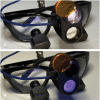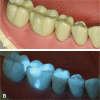Enhanced Clinical Decision-Making and Delivery of Minimally Invasive Care Using the ICCMS4D Integrated with Hands-Free Fluorescence-Based Loupes and a Chemomechanical Caries Removal Agent
- PMID: 37105220
- PMCID: PMC10756833
- DOI: 10.1055/s-0043-1764423
Enhanced Clinical Decision-Making and Delivery of Minimally Invasive Care Using the ICCMS4D Integrated with Hands-Free Fluorescence-Based Loupes and a Chemomechanical Caries Removal Agent
Abstract
The purpose of this case report was to evaluate an approach for enhanced clinical decision-making while providing minimally invasive treatment, using the combined International Caries Classification and Management System (ICCMS 4D) with hands-free fluorescence-enhanced loupes (Reveal, Designs for Vision Inc., New York City, NY, United States) and a chemo-mechanical caries removal agent (Papacárie Duo Gel, Formula & Acao, Sao Paulo, Brazil). In recent decades, a shift towards a conservative approach to caries management has developed. The use of adequate operative techniques and correct decision-making are of paramount importance for early caries detection and tooth-preserving operative care. The use of noninvasive fluorescence-based adjuncts for enhanced diagnostic accuracy has gained popularity. Fluorescence describes the absorption of photons by a molecule, followed by its partial emission at a longer wavelength. Fluorescence detection of bacterial activity is largely based on the red/orange fluorescence emanating from bacterial metabolism, and has been shown to be found particularly in active caries and mature anaerobic plaque. The combined approach of using the standardized visual International Caries Detection and Assessment System (ICDAS) with fluorescence as an operative adjunct was shown to enhance the advantages of both systems. The approach may potentially increase detection sensitivity without compromising the specificity of the visual tactile method. A recent hands-free device is aimed to combine simultaneous diagnosis and therapy (theragnosis) using fluorescence, while overcoming possible obstacles to workflow continuity. The "Reveal" fluorescence-enhanced loupes are fitted with a dual white light/fluorescence light, and are said to allow the clinician to conduct any operational procedure with optional fluorescence guidance, from detection to caries removal, to treatment completion. Using the described method, a comprehensive pathway that emphasizes evidence-based information, correct clinical decision-making, and a minimally invasive therapeutic approach was proposed. The approach may represent a potential advancement in providing minimally invasive caries care.
The Author(s). This is an open access article published by Thieme under the terms of the Creative Commons Attribution License, permitting unrestricted use, distribution, and reproduction so long as the original work is properly cited. (https://creativecommons.org/licenses/by/4.0/).
Conflict of interest statement
L.S. owns IP rights and touches royalties on Reveal.
Figures






Similar articles
-
Fluorescence-Enhanced Theragnosis: A Novel Approach to Visualize, Detect, and Remove Caries.Compend Contin Educ Dent. 2021 Sep;42(8):460-465. Compend Contin Educ Dent. 2021. PMID: 34449243
-
Use of new minimum intervention dentistry technologies in caries management.Aust Dent J. 2013 Jun;58 Suppl 1:40-59. doi: 10.1111/adj.12049. Aust Dent J. 2013. PMID: 23721337
-
Use of a laser fluorescence device for the in vitro activity assessment of incipient caries lesions.J Orofac Orthop. 2019 Nov;80(6):327-335. doi: 10.1007/s00056-019-00194-6. Epub 2019 Oct 7. J Orofac Orthop. 2019. PMID: 31591652 English.
-
International Caries Detection and Assessment System (ICDAS) and its International Caries Classification and Management System (ICCMS) - methods for staging of the caries process and enabling dentists to manage caries.Community Dent Oral Epidemiol. 2013 Feb;41(1):e41-52. doi: 10.1111/cdoe.12025. Community Dent Oral Epidemiol. 2013. PMID: 24916677 Review.
-
Chemomechanical Caries Removal: A Review & Study of an Indigen-ously Developed Agent (Carie Care (TM) Gel) In Children.J Int Oral Health. 2013 Aug;5(4):84-90. Epub 2013 Aug 28. J Int Oral Health. 2013. PMID: 24155626 Free PMC article. Review.
Cited by
-
Imaging of porphyrin-specific fluorescence in pathogenic bacteria in vitro using a wearable, hands-free system.bioRxiv [Preprint]. 2024 Nov 1:2024.05.20.595019. doi: 10.1101/2024.05.20.595019. bioRxiv. 2024. PMID: 39553962 Free PMC article. Preprint.
References
-
- Schwendicke F, Frencken J E, Bjørndal L et al.Managing carious lesions: consensus recommendations on carious tissue removal. Adv Dent Res. 2016;28(02):58–67. - PubMed
-
- Banerjee A, Frencken J E, Schwendicke F, Innes N PT. Contemporary operative caries management: consensus recommendations on minimally invasive caries removal. Br Dent J. 2017;223(03):215–222. - PubMed
-
- Pitts N. “ICDAS”: an international system for caries detection and assessment being developed to facilitate caries epidemiology, research and appropriate clinical management. Community Dent Health. 2004;21(03):193–198. - PubMed
LinkOut - more resources
Full Text Sources

